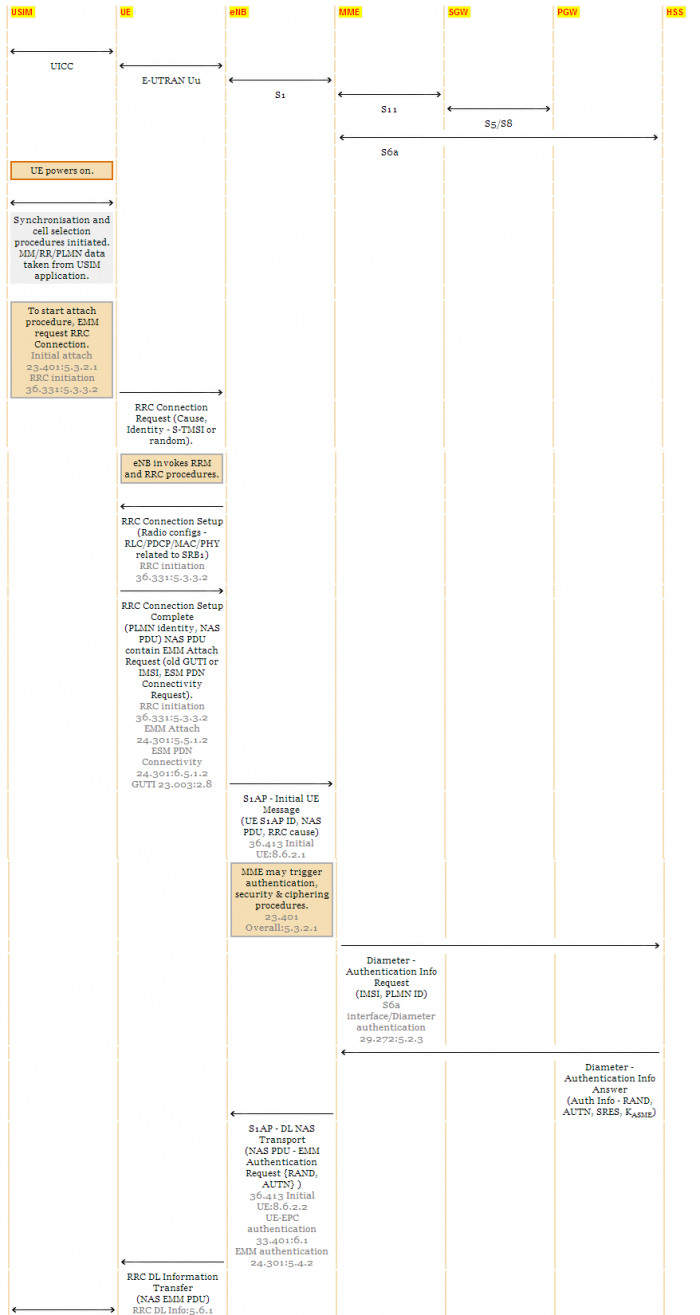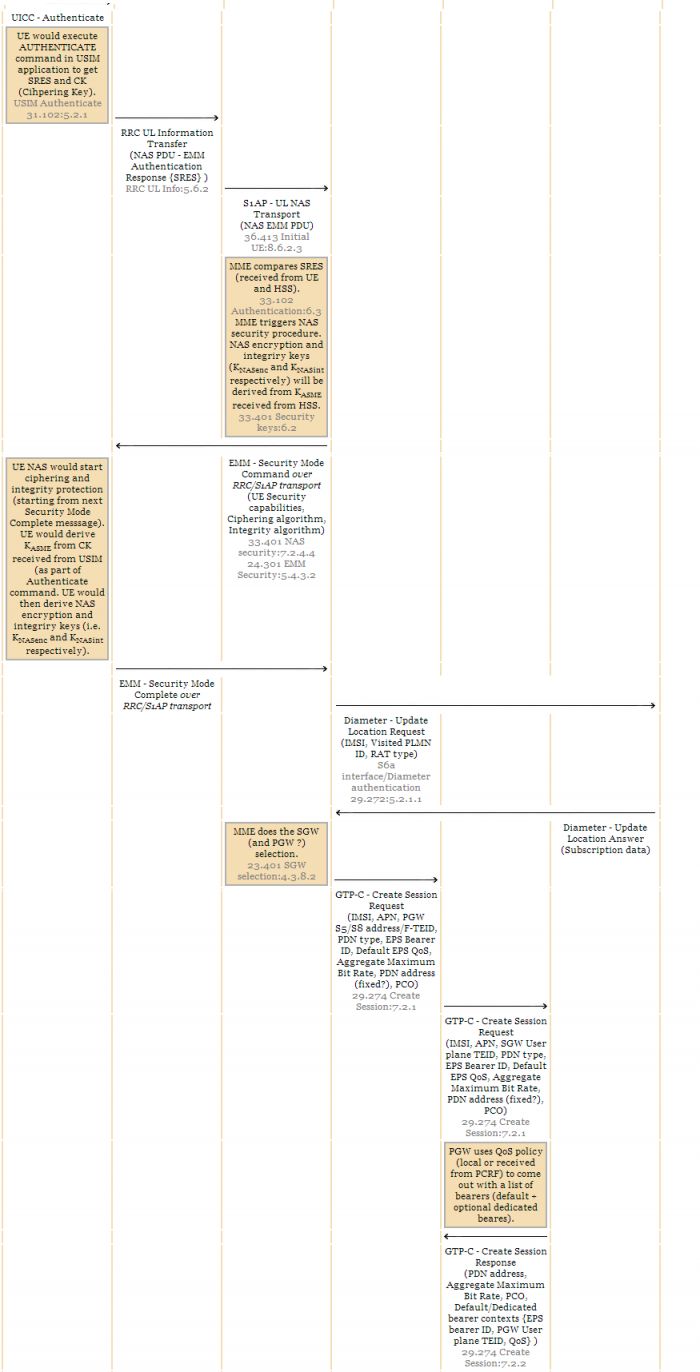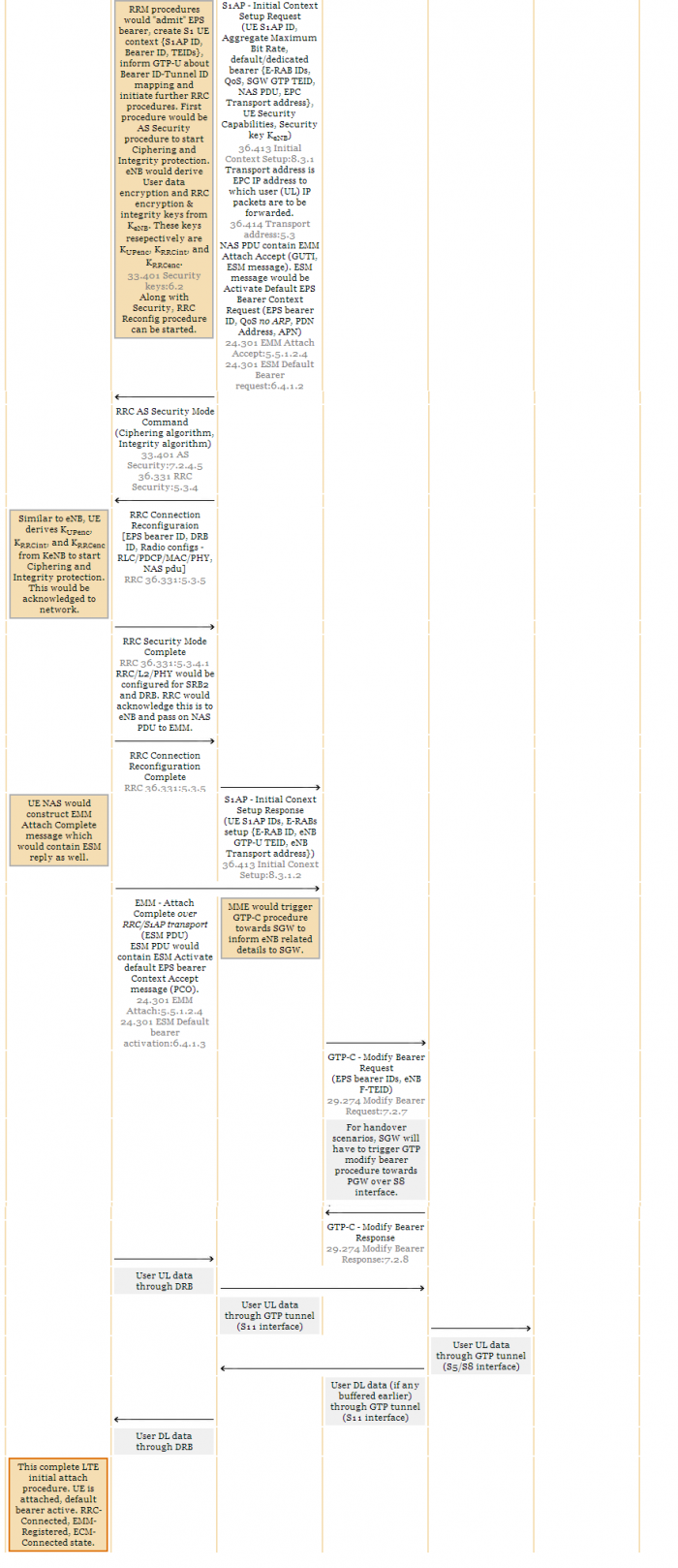There is a defined call flow for Long Term Evolution (LTE) when it comes to the network architecture; however, there is also an LTE attach procedure within that call flow. This LTE attach procedure is an important part of the structure and deserve special attention.
In SAE/EPS article, we looked at LTE network architecture; in this article, we will look at end-to-end initial UE attach signaling.
What is different with LTE UE initial attach ? In LTE, initial attach is combined with (default) PDN (IP) connectivity. You can call this default PDN (IP) connectivity as default (or basic or initial) PDP context activation. This default connectivity is always of non-guaranted bit rate type (basically something which handles mostly bursty internet traffic). This default connectivity is called "default bearer". LTE no more use NAS terminology of "PDP Context" for "Sessions". By the way, LTE NAS consists only of Mobility Management (EMM) and Session Management (ESM). Additional PDP Contexts or Sessions (with different QoSs than default bearers) are called "dedicated bearers". Yes, it is misleading to call it "dedicated"
The attach procedure may trigger one or multiple dedicated bearer establishment procedures to designate a dedicated EPS bearer for that UE. The UE may also make a request for an IP address allocation during the LTE attach procedure. Once this happens, the next steps begin and bearers are largely involved. Wired n Wireless explains the bearer request and response messages below:
Create Default Bearer Request: MME —-> S-GW
MME selects a S-GW and allocates an EPS bearer identity for default bearer associated with UE. Next, it sends a “create default bearer request.” This message provides a subscribed APN AMBR for the APN. MSISDN is included if the attach type indicates handover. Then, selection mode indicates that a subscribed APN was selected. Charging characteristics indicates which kind of charging the bearer context is liable for. hen it sends Create Default Bearer Request with following IEs: IMSI, MSISDN, MME TEID for Control Plane, PDN GW address, PDN Address, APN, RAT Type, Default EPS bearer QoS, PDN Type, APN-AMBR, EPS Bearer Identity (EBI), Protocol COnfiguration Options, Handover Indication, ME identity, User Location Information (ECGI), MS Info Change Reporting Support Indication, Selection Mode, Charging Characteristics, Trace Reference, Trace Type, Trigger ID, OMC identity, Maximum APN Restriction, Dual Address Bearer Flag, Protocol over S5/S8.
Create Default Bearer Request : S-GW ——–>PDN-GW
The S-GW creates a new entry in its EPS bearer table and sends a create default bearer request message to PDN GW, indicated by the PDN GW address received in the previous step. This message contains IMSI, MSISDN, APN, S-GW address for User Plane, S-GW TEID of the User Plane, S-GW TEID of the Control plane, RAT Type, Default EPS bearer QoS, PDN Type, PDN Address, Subscribed APN-AMBR, EPS bearer identity, Protocol Configuration Options, Handover Indication, ME Identity, user Location Information (ECGI), MS Info change Reporting SUpport Indication, Selection Mode, Charging Characteristics, Trace Reference, Trace Type, Trigger ID, OMC Identity, Max APN Restriction
Dual Address Bearer Flag.
Create Default Bearer Response : PDN-GW ——> S-GW:
The P-GW creates a new entry in its EPS bearer context table and generates a charging ID. This new entry allows the P-GW to route user plane PDU’s between the S-GW and the packet data network, allowing them to start charging. The PDN-GW returns a create default bearer response with following IE’s: PDN-GW address for the user plane, PDN GW TEID of the user plane, PDN GW TEID of the control plane, PDN Type, PDN address, EPS Bearer Identity, EPS bearer QoS, Protocol Configuration Options, Charging ID, Prohibit payload compression, APN Restriction Cause, MS Info Change Reporting Action, APN AMBR.
Create Default Bearer Response : S-GW ——–> MME
Finally, S-GW returns a create default bearer response to MME.
Just like "Secondary PDP Context" in GPRS/UMTS, dedicated bearer has same PDN (IP) address as default bearer and specific QoS. Yes, TFT (Traffic Flow Template) is utilised here (UE and PGW) too ! QoS is defined differently in LTE (check out 3GPP TS 36.300 section 13 and 23.401, section 4.7.3).
Below is a end-to-end signaling diagram for UE initial attach. I have included lot of specification references to dig in further.



